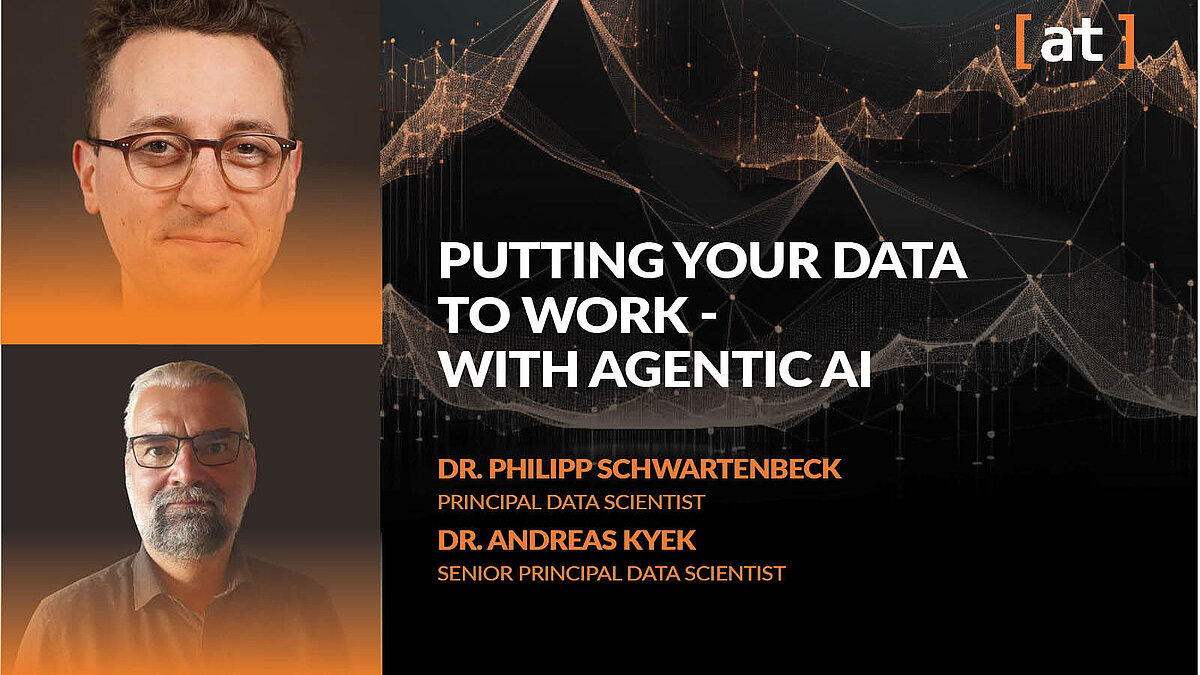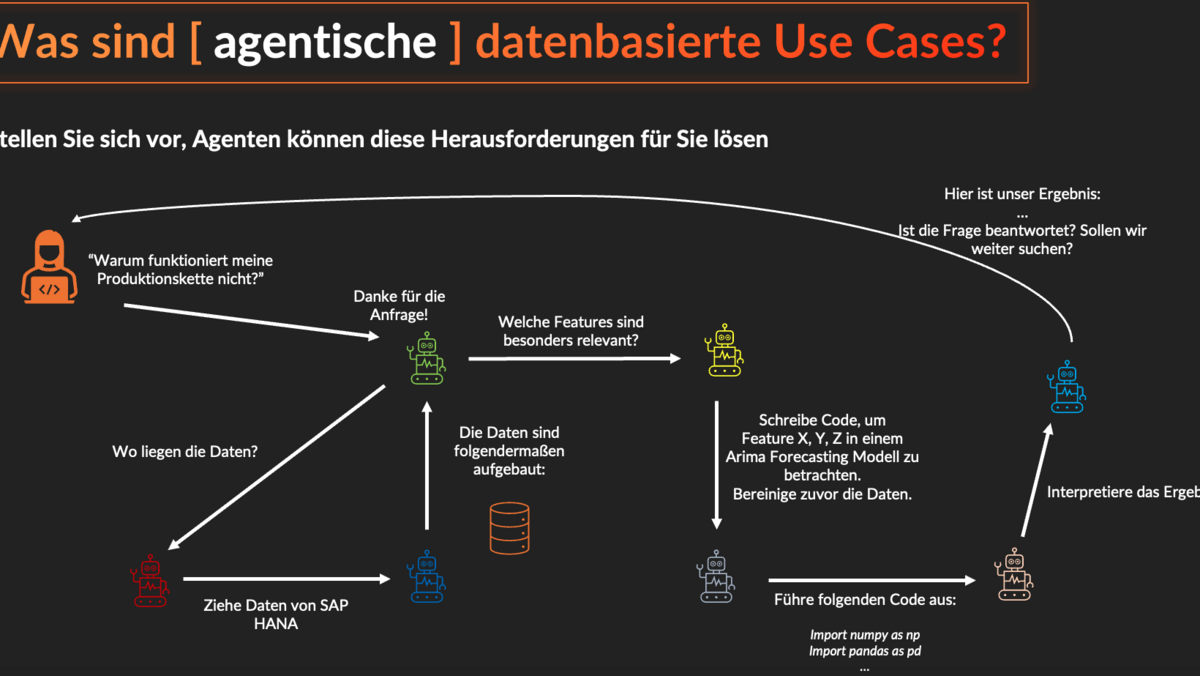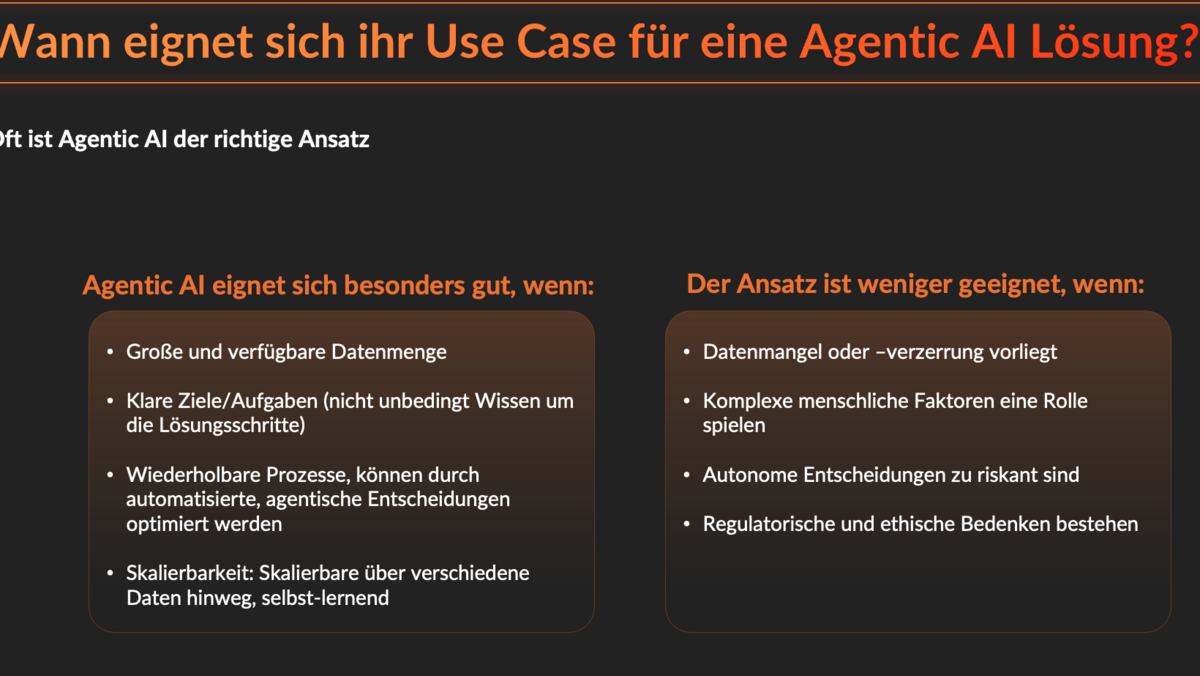Agentic AI
Putting your Data to Work
- Published:
- Author: Dr. Andreas Kyek, Dr. Philipp Schwartenbeck
- Category: Deep Dive
Table of Contents

In the modern business world, data is a driving force for success. Companies collect, analyze and use vast amounts of data to optimize their processes and achieve competitive advantages. However, despite rapid technological advances in the field of Artificial Intelligence (AI), many organisations face a major challenge: how can complex, data-based decisions be automated efficiently?
This is where Agentic AI comes into play – a technology that borrows its functionality from the way human expert teams work. Instead of using individual AI models for specific tasks, several specialized agents work together in an Agentic AI system to complete tasks. Agentic AI will be a crucial component of digital transformation in the coming years. According to Gartner, it is one of the top technology trends for 2025. So, let’s take a closer look at what’s behind it.
Interested in a more practical approach? Head over to the recording of our recent Webinar on Agentic AI, where our experts demonstrate the potential of Agentic AI for solving common Big Data issues. They specifically highlight cases for manufacturing, production and logistics. This webinar provides you with essential knowledge for taking the first step to implementing your own Agentic AI solution.
Lassen Sie Ihre Daten für Sie arbeiten - mit Agentic AI | Webinar | Alexander Thamm GmbH
What is Agentic AI?
Agentic AI describes a Multi-Agent-based system that processes tasks automatically and purposefully, independently and in collaboration with other Agents. These Agents can:
- Search and analyze data.
- Automate processes.
- Create and validate content.
- Make decisions and continuously optimize their results.
As opposed to traditional AI models, which often only act as support for humans, agent-based systems enable a higher level of automation and significantly reduce manual effort.
A classic example from production: a company is faced with the challenge of identifying errors in a production line. Instead of a manual, resource-intensive process, a multi-agent system can automatically analyse production data, recognise patterns and identify the causes of errors.

Making Business with Agentic AI
Traditional AI models have a high error rate when confronted with complex, dynamic environments. Agentic AI can solve this problem by intelligently linking specialised agents. Its main advantages are:
- Automation of repetitive tasks: Many business processes involve repetitive work steps that can be performed by AI Agents. For example, Agentic AI can automate test reports in production, extract data from SAP systems or analyze customer feedback. The automation of such tasks relieves employees of monotonous routine work, reduces sources of error and frees up time for value-adding, creative activities - a clear benefit for the company and its workforce.
- Scalability and Flexibility: Agent-based systems can easily adapt to changing requirements. New Agents can be easily integrated into existing workflows without having to adjust the entire system.
- Cost reduction and increased efficiency: AI Agents can deliver considerable cost savings. An example from the automotive industry shows that the automation of fault analysis can save up to 13 million euros per year.
- Self-learning systems: Agentic AI uses machine learning to continuously improve. With each new data set, the Agents become more intelligent and deliver better results.
- Resistance and reliability: As the Agents work in parallel and monitor each other, they can recognize and correct errors at an early stage.
Agentic AI Use Cases
Production: Error analysis and process optimization
In production, AI Agents can analyze production data from various sources (e.g. SAP, sensor data) and automatically identify the causes of errors. This allows for:
- Faster troubleshooting thanks to automated root cause analysis.
- Conservation of resources through reduction of manual analyses.
- Cost savings through avoidance of production downtimes.
Curious how this plays out in the real world? Take a look at our Agentic AI project with a car manufacturer.
Automated document creation
Agents can automatically generate, validate and optimise test reports, requirements documents or contracts. A multi-agent system can:
- Create and structure documents.
- Check legal conformity and quality.
- Synchronize content with existing data.
Predictive Maintenance
A digital maintenance assistant can analyze real-time data from machines and provide automatic recommendations for action. Agents monitor operating states, recognize anomalies and inform technicians about necessary measures.
Intelligent Customer Feedback Analysis
Companies gather vast amounts of customer feedback — but how meaningful is it really? A multi-agent system can correlate that feedback with real operational data to separate actual issues from subjective perceptions.
Automated Decision-Making in the Financial Sector
Banks and insurance companies use Agentic AI for the automated analysis of financial data, risk assessments and fraud detection. Agents can monitor transactions in real time and recognize suspicious patterns.
Technical Introduction: How does Agentic AI work?
Multi-Agent Architecture
Every Agentic system consists of various specialized Agents that take on specific tasks:
- Data Agents search for and extract relevant information.
- Analysis Agents interpret the data and draw conclusions.
- Decision Agents take optimized measures based on the results.
- Interaction Agents communicate with the user and provide feedback.
If you would like to dive deeper into the architecture of AI Agents, we recommend our blog post on the subject. Here, we explain what constitutes AI Agents, how they are organized and the central concepts underlying their functionality. We also present leading frameworks and tools that support the development of such systems.
LLMs as central Building Blocks
Modern Large Language Models (LLMs) play a central role in agent-based systems. They allow for:
- Processing of large amounts of data in natural language.
- Automated text generation and summarization.
- Interaction with users via chatbots or digital assistants.
RAG for better decision-making
RAG (Retrieval Augmented Generation) combines LLM generation with a database query to deliver informed answers. This produces more accurate and trustworthy results.
How to get started with Agentic AI
Not every use case is a good fit for Agentic AI. Companies should first assess whether the following conditions are in place:
- Large amounts of data: An Agentic system requires comprehensive and available data.
- Repeatable processes: Agents can automate standardised workflows.
- Clear goals: The use case should pursue a concrete goal, even if the solution steps are not precisely defined.
- Scalability: Agentic AI is ideal for applications that grow with increasing data volumes.
Agentic AI is less suitable if:
- There are data deficiencies or biases.
- High uncertainty makes autonomous decisions risky.
- Regulatory and ethical concerns play a role.

Conclusion: Agentic AI as the key to Digital Transformation
Agentic AI is revolutionizing the way companies work with data. Instead of using isolated AI models, Agentic AI systems combine various specialized AI Agents to create more efficient, scalable and self-learning solutions. Whether in manufacturing, document creation, maintenance or finance, these AI Agents can automate processes, reduce costs and enable new business models. Companies that embrace this technology early on will secure a decisive competitive advantage. Are you ready for the future of data-based decision-making?
Share this post:
